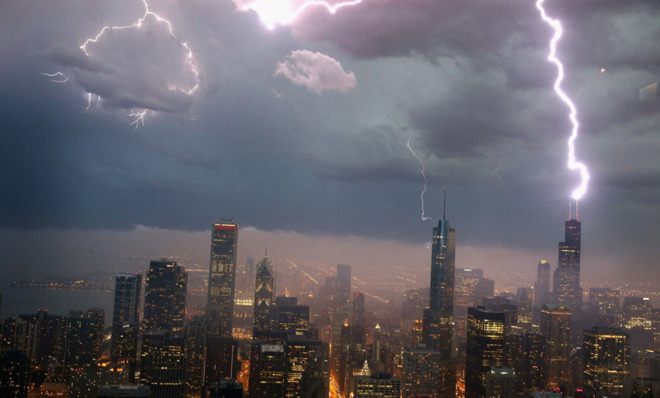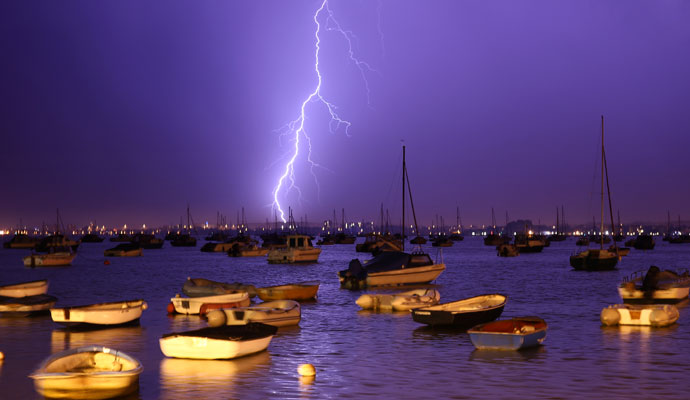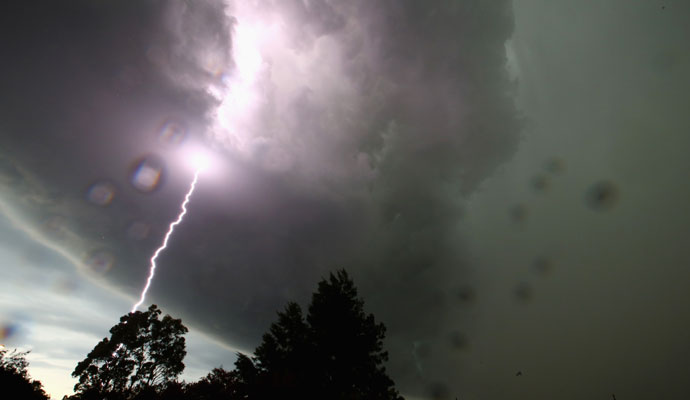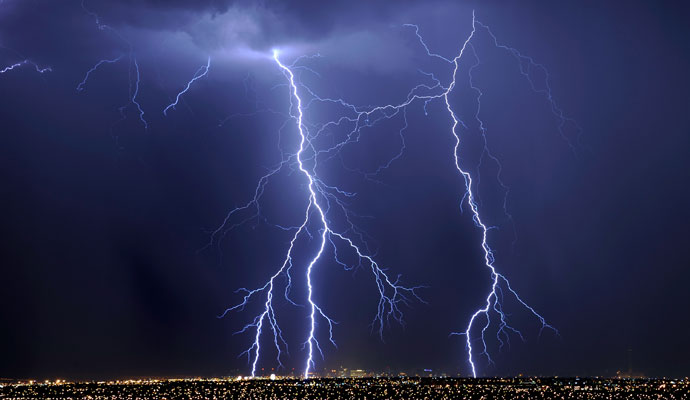What it's like to survive a lightning strike
Each year, hundreds of people live after being struck by lightning. But their minds are forever altered.

MICHAEL UTLEY DOES not remember much about his death.
Over the years, he has woven together a narrative of what happened using threads collected from witnesses, friends, and family. On May 8, 2000, Utley, a 48-year-old stockbroker, was golfing with his co-workers Dick Gill and Bill Todd, along with their friend Jim Sullivan, in the village of Pocasset, Massachusetts, about three miles south of the Cape Cod Canal. Shortly after lunch, the dark clouds that had been mushrooming in the distance all morning were hovering close enough to merit the bleating of the course's storm horn — time to clear the green.
Gill, Todd, and Sullivan immediately headed toward the clubhouse. Utley walked back to the hole and returned the flagstick. Seconds later, the guys in front heard a thunderous crack and turned to see Utley stumbling to the ground, tendrils of smoke curling off his body. Their friend had collapsed in a single perplexing instant. His shoes were several feet away from his body; his fingers looked as if they had been flambéed; his eyebrows and wavy chestnut hair were wiry and crisped. Gill, an ex-Marine who had recently taken a refresher course in CPR, ran to Utley's side, began blowing air into his lungs, and instructed Todd to perform chest compressions. As Sullivan rushed off to get help, the clouds unleashed a deluge of rain and hail.
The Week
Escape your echo chamber. Get the facts behind the news, plus analysis from multiple perspectives.

Sign up for The Week's Free Newsletters
From our morning news briefing to a weekly Good News Newsletter, get the best of The Week delivered directly to your inbox.
From our morning news briefing to a weekly Good News Newsletter, get the best of The Week delivered directly to your inbox.
Utley cannot recall any of this. Not the arrival of the paramedics, nor having his heart restarted in the ambulance on the way to the hospital. His first memory after leaving the golf course is of waking up in a different ambulance, tubes down his throat, monitors everywhere, and a paramedic in a blue smock at his feet.
"Where am I?" Utley rasped.
"You're on your way to rehab," the paramedic said.
"What the f--- happened?"
A free daily email with the biggest news stories of the day – and the best features from TheWeek.com
"You were struck by lightning 38 days ago."

IN POPULAR CULTURE, to be hit by a bolt of lightning is to suffer extremely bad luck. Rain, snow, and hail are largely indiscriminate: Within a certain radius, everything is drenched, blanketed, or pelted. A cloud-to-ground lightning bolt is different. It blazes a discrete path through the sky. It appears to have choice. When lightning hits a human being, a survivor must reconcile not only what happened but why it happened. Why me?
For most victims, it is not the unforgettable horror of an agonizing ordeal that haunts them — many can't even recall the incident itself; it's the mysterious physical and psychological symptoms that emerge, often long after their immediate wounds have healed and doctors have cleared them to return to their normal routines. But nothing is normal anymore. Chronic pain, memory trouble, personality changes, and mood swings can all follow an encounter with lightning, leaving friends and family members confused, while survivors, grappling with a fundamental shift in identity, feel increasingly alienated by the incomprehensible nature of their condition.
Even more confounding is that almost no one in the mainstream medical community can explain what's happening to them. Although many scientists have spent their careers examining the physics of lightning, only a handful of doctors have devoted themselves to the study of how lightning damages the human body. The incident rates are simply not high enough to warrant an entire subfield of science.
True entry and exit wounds are uncommon, but lightning typically leaves some kind of mark on the skin. One afternoon in 2009, a hiker named Becky Garriss awoke on the Appalachian Trail in Vermont, sitting on a bed of pine needles, her back against a tree, as though she'd fallen asleep in its shade. Her right arm was paralyzed, pinned against her chest in a pledge of allegiance. Here and there, her pants were charred. Although she was disoriented and scared, she managed to hike more than 10 muddy miles down Glastenbury Mountain to call for help. When she got to a hospital, doctors recognized lightning's smoldering touch on Garriss's right arm and leg. A bolt probably hit her directly, they told her.
Other survivors awaken into temporary blindness or deafness; sometimes the concussive force of the strike — or the electricity itself — ruptures eardrums. Some victims report the taste of metal on their tongues. Now and then, survivors develop strangely beautiful pink and brown bruises known as Lichtenburg figures, which look like intricate henna tattoos of branching fronds. These bruises likely trace the path of electricity that forced blood cells out of capillaries into more superficial layers of skin.
In rare instances, the surge of electricity is enough to stop a victim's heart and lungs. That's what happened to Utley. But cardiac arrest is something any paramedic knows how to handle. Twenty minutes after Utley was struck, EMTs had arrived on the scene, strapped him to a gurney, and loaded him into an ambulance. They used a defibrillator to keep his heart going.
After leaving the hospital for rehab five weeks later, Utley spent months relearning to swallow, move his fingers, and walk. Rehab was just the first chapter of his ordeal, however. In his previous life, Utley was a successful stockbroker who often went skiing and windsurfing. Today, at 62, he lives on disability insurance in Cape Cod. "I don't work," he says. "I can't work. My memory's fried, and I don't have energy like I used to. I aged 30 years in a second. I walk and talk and play golf — but I still fall down. I'm in pain most of the time. I can't walk 100 yards without stopping. I look like a drunk."
Lightning also dramatically altered his personality. "It made me a mean, ornery son of a bitch. I'm short-tempered. Nothing is fun anymore. I am just not the same person my wife married," says Utley, who is now divorced. Like many survivors, Utley sees his fateful union with lightning as more than just a close call he was lucky to survive. It marks a moment in which he was split from himself.

ON A TYPICAL summer afternoon, thunderclouds above the continental United States generate an average of 50,000 lightning flashes per hour. Two-thirds of these stay near the heavens. They pierce the sky with branching networks of blue and white fire, or strike out a short distance in thin tongues of electricity, or illuminate clouds from within like muffled firecrackers. The remaining minority of lightning bolts, however, find earthbound targets — a church steeple, a telephone pole, a tree.
Even rarer are bolts that directly strike and kill humans. Not surprisingly, the vast majority of these fatalities in the U.S. happen in June, July, and August, the months when thunderstorms are more prevalent and the greatest number of Americans are recreating outside. According to a recent National Weather Service analysis, fishing, boating, swimming, and camping put the most people at risk each year. Last July, two visitors in Colorado's Rocky Mountain National Park were killed by separate strikes on the same weekend.
When people and lightning meet, however, death is an unlikely outcome. Roy Cleveland, a ranger at Shenandoah National Park in Virginia, survived a record seven strikes from 1942 to 1977. This fact appears to defy logic. An average lightning bolt carries 500 megajoules of energy — enough to instantly boil 250 gallons of water. It heats the air it zips through to five times the surface temperature of the sun. Still, around 90 percent of lightning-strike victims survive. Over the past three decades, lightning has killed an average of 51 people per year in the U.S. but left more than 500 injured and alive.
One explanation is that lightning strikes are fundamentally different from the more common high-voltage electrical accidents. When an electrician inadvertently grabs a live wire, far less current typically seizes him than is contained in a lightning bolt, but it does so for a longer duration. The surge of current causes victims to lose control, rendering them unable to let go. After a few seconds, the electricity coursing through the body has enough time to sear internal organs and interrupt the heart. Lightning strikes, lasting less than a half-millionth of a second, often scorch the skin but don't cause internal burns.
Just as crucial, most of the electricity in a lightning bolt does not pass through the body. Rather, it dissipates over the skin in what's known as a flashover. Vernon Cooray, a lightning scientist at Uppsala University in Sweden, explains the phenomenon by contrasting the ways a human body and a tree react when struck. Both trees and people are filled with a soup of water and minerals that conduct electricity pretty well. But because trees are covered in dry, inelastic bark, lightning traveling through the trunk has no escape route. It must stay its course. In the process, it superheats the water and sap inside the tree into explosive steam, which can rip apart the trunk and branches.
Compared with tree bark, human skin is much more pliant and moist. Sweat and rainwater make it extra conductive, providing an alternate external path for voltage. Most of the electricity can pass over strike victims rather than coursing through them. "The path through the body has much greater resistance than the path around the body," says Vladimir Rakov, a University of Florida researcher and a leading authority on lightning physics. "Current always chooses the path of least resistance."
A flashover can still do damage indirectly. The electricity crackling over the surface of the human body singes clothing, vaporizes sweat and moisture into scalding steam, and renders metal objects like belt buckles, keys, and jewelry so hot that they burn the skin. Occasionally, all that steam even blows victims' shoes and socks off.

FOR UTLEY, GETTING adequate treatment after he recovered was a struggle. He was eventually fortunate enough to find a few doctors who helped him cope with the long-term symptoms, but along the way he met many medical experts who understood little or nothing about his injuries.
"Finding a doctor who knows anything about a lightning strike is next to impossible," says Tamara Pandolph-Peary, 46, who was struck by lightning in August 2010, in the parking lot of the Springfield, Illinois, Men's Wearhouse where she worked.
Following her accident, Pandolph-Peary forgot how to use everyday objects, like a potato peeler; she could no longer get from Point A to Point B in her hometown; she suffered migraines and fatigue; she tripped over her sentences; she was often dizzy and off balance; and every now and then, when her nerves were on fire, even the slightest touch was painfully intense.
"I struggled with the 'Why me?' initially," she says. "There was a time I was angry. I think I got past that part. You can be angry and hold on to that, and it can ruin everything you have left."
Utley, too, has trained his mind on the future. Despite the personality change and relentless pain — despite the hunger for an explanation that would make sense of it all — he no longer fixates on a "why" that probably doesn't exist. "Yeah, I was pissed at first," Utley says. "Why did I get struck and not the three guys 15 feet away from me? There's no rhyme or reason. You can ask questions all you want, but it's like yelling at the ocean. It does not answer back."
Excerpted from an article that originally appeared in the October 2014 issue of Outside. Reprinted with permission.
-
 Russia’s ‘weird’ campaign to boost its birth rate
Russia’s ‘weird’ campaign to boost its birth rateUnder the Radar Demographic crisis spurs lawmakers to take increasingly desperate measures
-
 Could smaller cars bring down vehicle prices?
Could smaller cars bring down vehicle prices?Today’s Big Question Trump seems to think so, but experts aren’t so sure
-
 2025’s most notable new albums
2025’s most notable new albumsThe Week Recommends These were some of the finest releases of the past year